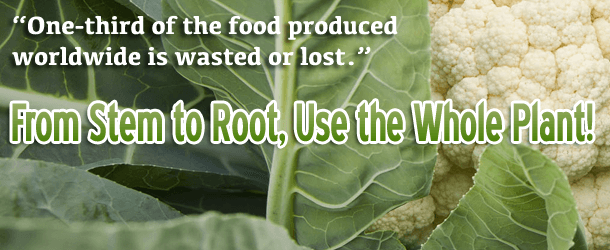
We lop off broccoli stems, snip away carrot tops and snap woody ends from asparagus without a thought. The mindless tossing of scraps, peels and other produce trimmings is the norm in today’s kitchens. Flashback a generation or two ago when frugality reigned and those bits and pieces would never have been wasted; what wasn’t served on the plate went into the next day’s stew or stockpot.

An Eco-friendly and Economical Trend
Fed more by eco-awareness than economic necessity, chefs are finding newfound inspiration to cook with the entire plant, “root to stem,” using culinary ingenuity to blur the line between compost and cuisine.
On trend with “nose to tail” eating, where chefs utilize all parts of the animal, “root to stem” minimizes food waste and lowers your dietary carbon footprint. One-third of the food produced worldwide is wasted or lost, which uses up energy and produces carbon emissions as it decomposes.
The Food and Agriculture Organization found that waste rates for fruits and vegetables were the highest of any food.
Tossing Out Nutrients
It was the introduction of industrialized foods and the awareness of pesticides that changed people’s perception of fruit and vegetable peels, rinds and greens from healthy, nutrient-rich food ingredients (nutrients are often concentrated in the skins or just beneath) to something unhealthy, unsafe and unattractive.
In just a short time, we’ve become so distanced from the entire plant that we no longer know that cauliflower leaves, for example, are edible and nutritious, or that broccoli stalks are delicious shaved into a crunchy salad with lemon.
Summer is just around the corner and many farmers markets are already ripe with fresh produce. (Organic is the safest choice for root-to-stem eating to protect against consuming chemicals from fertilizers and pesticides.) Turn a fresh view to the season’s bounty and experiment with every root, stalk, leaf and stem. Don’t miss out on the powerful nutrients you may be throwing away.
Forgotten Food Parts
1. Greens or Tops
Fruit or vegetable: carrots, beets, turnips
Culinary use: Saute or use in green smoothies
2. Leaves
Fruit or vegetable: broccoli, Brussels sprouts, cauliflower, celery
Culinary use: Flavor and garnish salads and soups; substitute for cabbage
3. Stems
Fruit or vegetable: chard, kale, collards
Culinary use: Braise or saute
4. Stalks
Fruit or vegetable: broccoli, asparagus ends
Culinary use: Sliver for slaw; coin or cut into dipping sticks
5. Peels
Fruit or vegetable: pototo, citrus
Culinary use: Bake potato peels for snacks; use citrus for zest or candied
6. Rinds
Fruit or vegetable: watermelon
Culinary use: Cut outer peels and use in place of cucumber in salads
– Environmental Nutrition
(Reprinted with permission from Environmental Nutrition, a monthly publication of Belvoir Media Group, LLC. 800-829-5384. www.EnvironmentalNutrition.com.)
(c) 2012 BELVOIR MEDIA GROUP DISTRIBUTED BY TRIBUNE MEDIA SERVICES, INC.

